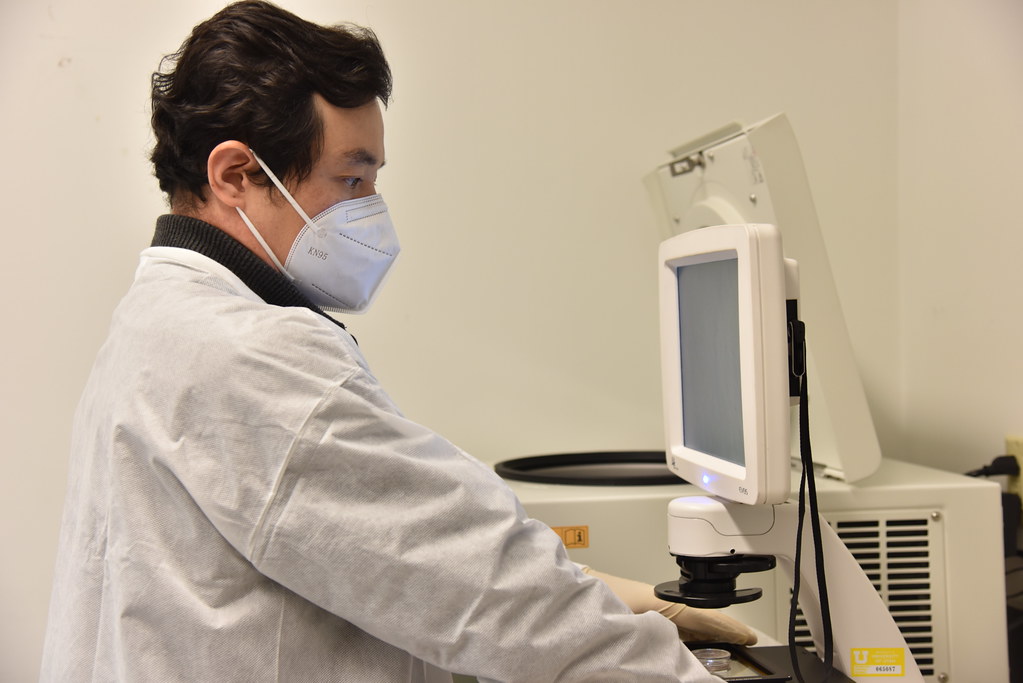Cell sheet development promises better treatment for destroyed tissue

By Lauren Hines | Bond LSC
Imagine a sticker a few centimeters wide and as thin as a strand of human hair except made of cells. For medicine, this sticker — called a cell sheet — can regenerate tissue damaged by chemotherapy radiation wherever it’s placed.
Kihoon Nam uses cell sheet technology to help head and neck cancer patients who have lost the ability to produce saliva due to chemotherapy radiation at the Bond Life Sciences Center.
“[Without] saliva, you will have difficulties in eating, tasting and speaking,” said Nam, assistant research professor in the Olga Baker lab. “Sometimes you can get an infection. In that case, they would need to use medications, saliva substitutes or the other biomaterial, but current treatments provide only temporary relief and result in significant side effects. So, I wanted to make some nice new alternative approach for this kind of patient.”
Cell sheets are exactly as cool as they sound. They’re single or multiple layers of cells, similar to the top of a sticker. These cells come from a patient or donor and they can make an organ-like structure. If the cell sheet was produced using stem cells, they can turn into almost any type of cell or tissue.
Once the cells are harvested, they’re prepared using a temperature-responsive culture dish. As temperatures reach below 25°C, cells spontaneously detach, and the extracellular matrix adheres to the patient’s tissue like the back of a sticker.
For the Baker lab, cell sheets have the potential to help regenerate salivary gland tissue and therefore regain patients’ abilities to produce saliva.
Before cell sheets, doctors and scientists would try to restore cells damaged by radiation therapy by collecting healthy cells of the same tissue from the patient or a donor. Then, they isolate the cells using a certain enzyme and inject the cells into the patient to spread.
However, the enzyme caused cell damage, inhibited the cells from changing into other types of tissues, and caused side effects to the patient.
“If you use an enzyme to collect cells and use them for the treatment, you need additional glue-like polymer or biomaterials to transport cells,” said Nam. “If you add this kind of glue with cells, it may cause some side effects because it’s not our cell-derived materials. However, if we create this cell sheet with its own glue like the extracellular matrix, they cannot make any side effects.”

Teruo Okano, the principal investigator at the University of Utah, started working towards a better system in 1984. After ten years studying temperature-responsive hydrogels, he went back to Japan where he worked with medical doctors to develop cell sheets
This new technology bypasses the need to use enzymes, and, instead, it uses polymers that change their structures as temperatures decrease in order to keep the cells together
“We can get the cells from the dish without any disruption in the cell and extracellular matrix protein,” said Kyungsook Kim, research assistant professor in Okano’s lab at the University of Utah. “So, this cell [therapy] is really functional.”
Cell sheet technology has been used in hospitals in Japan and Europe for eye, throat and heart tissue. The Okano lab has performed clinical research on periodontal, lung, middle ear, cartilage and heart tissue. However, cell sheet technology still has a way to go
“It’s a little expensive,” Nam said. “The other problem is that the cell sheet is very sensitive…the thickness of a cell sheet is about 100 microns. So, if you shake it, it is destroyed.
The technology also requires a high level of expertise, practice and environmental control care.
While cell sheets are in hospitals, it needs to be further developed for all kinds of tissues to make a difference for all kinds of patients. And so, the Baker lab continues to refine the process to develop them to restore salivary glands.
“If someone has cancer, they will get radiation therapy or chemotherapy,” Nam said. “In many cases, they lost their cell function and organ function. In that case, we can use saliva substitutes, but we cannot cure it 100%…We can keep patients’ cells before treatment. Then at the treatment with radiation therapy or other therapy, if they lost their organ function, we could cure this with their own cells.”
Read more about cell sheets and what else goes on in the Baker lab in their latest papers in Nature Regenerative Medicine and Cells.

